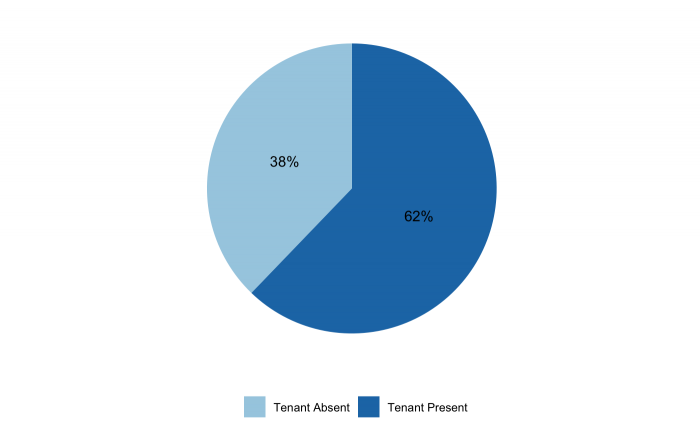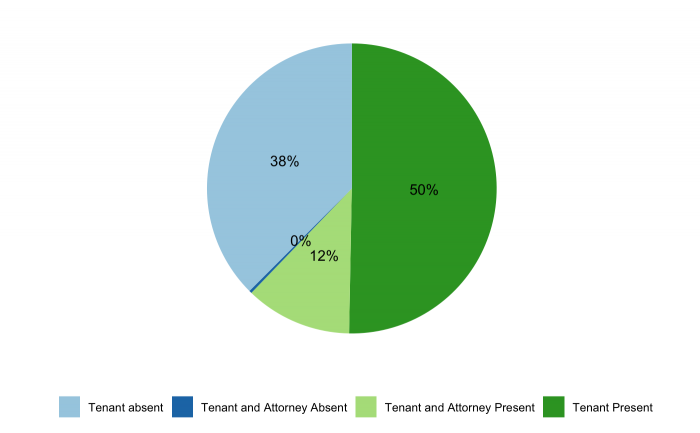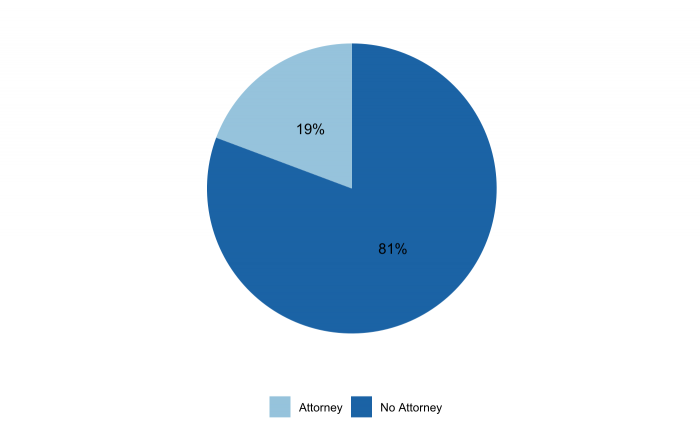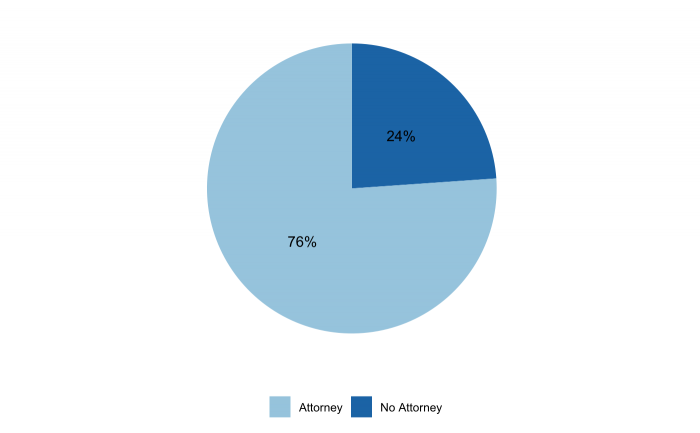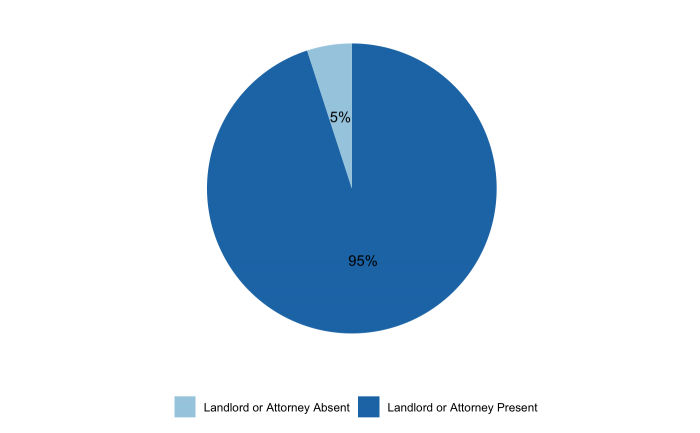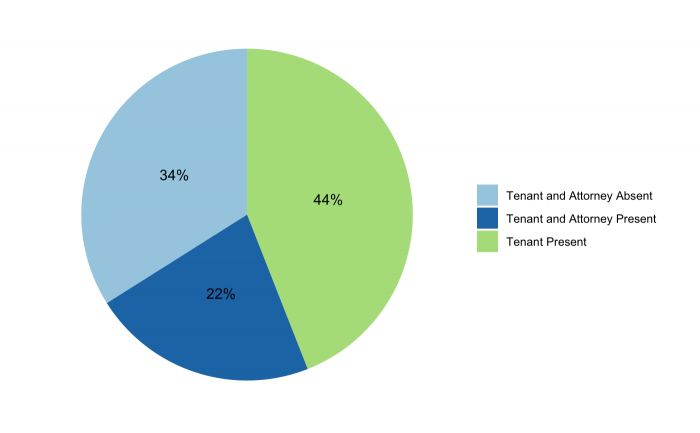Brian Filipiak
Introduction
Who appears in court has a large impact on the decisions made in the courtroom. Non-appearances by landlords can lead to dismissals of their petitions. Non-appearance by tenants can result in immediate warrants being granted. Self-Represented landlords may not have the same knowledge of the laws as lawyers who represent landlords on a daily basis. Thus appearance and representation play a large role in how the cases turn out. In this section, we will look at different rates of appearance and representation of tenants and landlords.
Methods
We collected data based off court records of Landlord-Tenant cases in 2017. We were able to analyze who was and was not present at each case. For more information on our data set, please click here.
Then to best analyze who appears, we removed any case that was initially withdrawn because the tenant does not have to be present in this situation. They may have come to an agreement before the case was heard, and the landlord or their attorney would tell them not to come.
Once we generated this smaller data set, we could see who appeared and who had representation in the courtroom.
Tenant Appearance:
Tenant Appearance
One of the first rates we wanted to determine was what percentage of tenants who appeared for their cases. This calculation does not include if they were represented by an attorney and were not present. Surprisingly, only about 62.2% of tenants appeared for their cases. That is an incredibly large percentage of cases where the tenant did not show up. This is interesting because a likely result would be a warrant being granted with immediate service due to no appearance. Based on our sample, we can estimate that tenant non-appearance rates in the full population of cases lies between 33.9% and 41.7%. This means over ⅓ of tenants will not appear for their hearing.
Tenant Representation When They Appear:
Appearance in Court
After looking at the rates at which tenants appear for their case, we thought looking at the rate at which those tenants that appeared had representation with them (i.e., an attorney) would be important. The standout number here is that 37.4% of cases don’t have a tenant or their representation appearing. That means that in those cases, no one is there to speak for the tenant, so a warrant will be granted usually for immediate service. In about 1 out of every 8 cases will a tenant appear and be represented, and in 1 of every 2 cases will the tenant appear but have no representation. That is the largest category of cases and is consistent with our courtroom observations.
Tenant Representation
Building off the last chart, this chart represents the percentages of tenants that appear that have representation. Only 20% (1 out of every 5 cases) does a tenant have representation. This means that a majority of the time, tenants have to be their own representation even though they may not know all the laws surrounding their case.
Landlord is Represented by an Attorney:
Landlord Representation
The rates at which landlords appear are extremely important to the case as well. Here, we looked at the rates at which the landlord is represented by an attorney. Landlords are represented by an attorney in 76.1% of cases or 3 out of every 4 cases. This does not include if the landlord represents themselves, and that would increase the total percentage of cases where a landlord is represented. Based on our sample, at most every 4 out of 5 cases has the landlord represented by an attorney.
One Petitioner or Petitioner’s Attorney Appears:
Landlord Appearance
As with the tenants, we wanted to look at the rate at which either or both a petitioner and their attorney appear. This is important because without the petitioner or their attorney present, a case is unlikely to proceed. The last section showed that about 75% of cases have a landlord who is represented by an attorney; this would be corroborated by courtroom observations. In approximately 95% of cases, a petitioner or their attorney appear. This means that it is very unlikely to have no one from the petitioner side to show up for a case. This means that if a tenant misses court, it is unlikely that the landlord will miss court as well.
Equally Resourced Tenants and Landlords
In this section, we are looking at the rates that tenants and landlord have the same resources (i.e., equally representation or non-representation).
Self Represented Landlords
First, we will look at self represented landlords; these are landlords that do not have attorneys with them in court. In those cases, tenants also don’t have representation 44% of the time. In just under 1 out of every 4 cases, a tenant does have an attorney with them. This could give the tenant a boost as the attorney may know more about the laws than the self represented landlord; therefore, they may be able to get the case dismissed. Also, in 1 out of 3 cases, no tenant or attorney is present. That means that they will likely have a warrant being granted with immediate service against them due to not appearing.
Attorney Represented Landlords
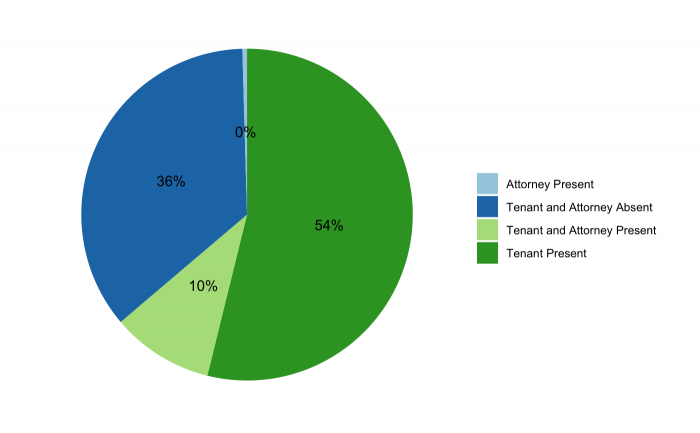
This pie chart shows the representation of tenants in cases against a Landlord that has an attorney.
Now, we will look at landlords who are represented by an attorney. In over 50% of cases, tenants do not have an attorney with them. This gives the landlord’s attorney an advantage because they will know the law better than the tenant. In only 1 out of 10 cases is the tenant on an equal resource level. This means they also have an attorney who will know the law as well as the landlord’s attorney. Once again, we see that there is no appearance by a tenant or their attorney in just over 1/3 of cases. This will result in warrant being granted with immediate service against them due to not appearing.
